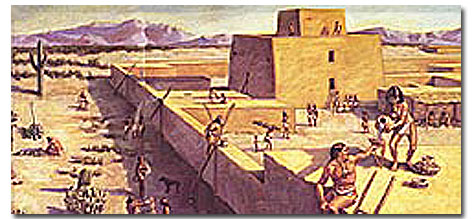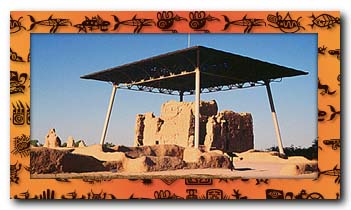200 B.C. -- 1450 A.D
The Hohokam peoples occupied a wide area of south-central Arizona from roughly Flagstaff south to the Mexican border. They are thought to have originally migrated north out of Mexico around 300 BC to become the most skillful irrigation farmers the Southwest ever knew.

The ingenious Hohokam developed an elaborate irrigation network using only stone instruments and organized labor. Before modern development obliterated this system, their predecessors commonly referred to them as the Canal Builders.

The Hohokam were creative artisans who became famous for their intricate work with shells obtained from the Gulf of California and the Pacific coast. They created a coiled pottery finished with a paddle and painted with red designs. They retained a great deal of Mesoamerican influence as can be seen in their use of ball courts and decorative feathers.
They also became entrepreneurs in a thriving trade with their neighbors, the Anasazi and the Mogollon. Their fate is unclear, but they seem to have disappeared from the archeological record between the first half of the 15th century and the time when the Spanish first came upon their descendents, Pima-speaking Indians still using the ancient irrigation techniques. Some of their original irrigation canals are still being used in the Phoenix area today!
Hohokam Archeological Sites
Casa Grande Ruins National Monument, AZ
Catalina State Park, AZ
HohHardy Site, AZ
Hohokam-Pima National Monument, AZ (Snaketown)
Painted Rocks Park, AZ
Sabino Canyon Recreation Area, AZ
Saguaro National Park, AZ
https://www.desertusa.com/ind1/du_peo_hoh.html


~ ~ ~

From American Archaeology MagazineCurrent Issue
The Mystery Of Hohokam Ballcourts
More than 200 ballcourts have been found in Arizona. For decades archaeologists have been trying to understand why they are there and what purpose they served.
Mar 15, 2018
Spring 2018: By Alexandra Witze.
From the Olmec to the Maya to the Aztec, ballgames were one of the defining activities of Mesoamerican cultures. Beginning some time before 1200 B.C., competitors kicked and whacked rubber balls up and down a playing court. These ballgames were rich in symbolism—in some cases the gods were said to have played—and a powerful force that bound communities together. But it’s possible these games weren’t limited to Mesoamerica. Archaeologists have found more than 200 oval-shaped earthen depressions with embankments in central and southern Arizona that resemble the Mesoamerican ballcourts. These features date between roughly A.D. 750 and 1200 and are associated with the Hohokam culture.
Though archaeologists continue to debate their purpose, and ethnographic accounts are silent on this matter, most researchers now surmise that the Hohokam courts were used for ballgames, much as the Mesoamerican ones were, according to Henry Wallace, a senior research archaeologist with Desert Archaeology, Inc., in Tucson, Arizona. In doing so the courts played a major role in strengthening Hohokam identity and interactions among villages. “Whenever you have games, you have people coming together,” Wallace said. “It’s a great way of linking social groups.”
New research suggests that the Hohokam ballcourts could have spread as part of a burgeoning religious revitalization movement. Villagers may have picked up on the Mesoamerican style of playing and adapted it to their own purposes. In some locations, such as Pueblo Grande in Phoenix, Hohokam ballcourts are large, intact ovals surrounded by earthen embankments. In other places they have been eroded, buried, or destroyed. According to a database maintained by Andy Laurenzi at Archaeology Southwest in Tucson, there are at least 220 ballcourts at 181 sites across Arizona. Most sites have one ballcourt, although several have more than one, including the well-studied site of Snaketown along the Gila River, which has both a large and a small court.
https://www.archaeologicalconservancy.org/the-mystery-of-hohokam-ballcourts/
~ ~ ~

 = new reply since forum marked as read
= new reply since forum marked as read





